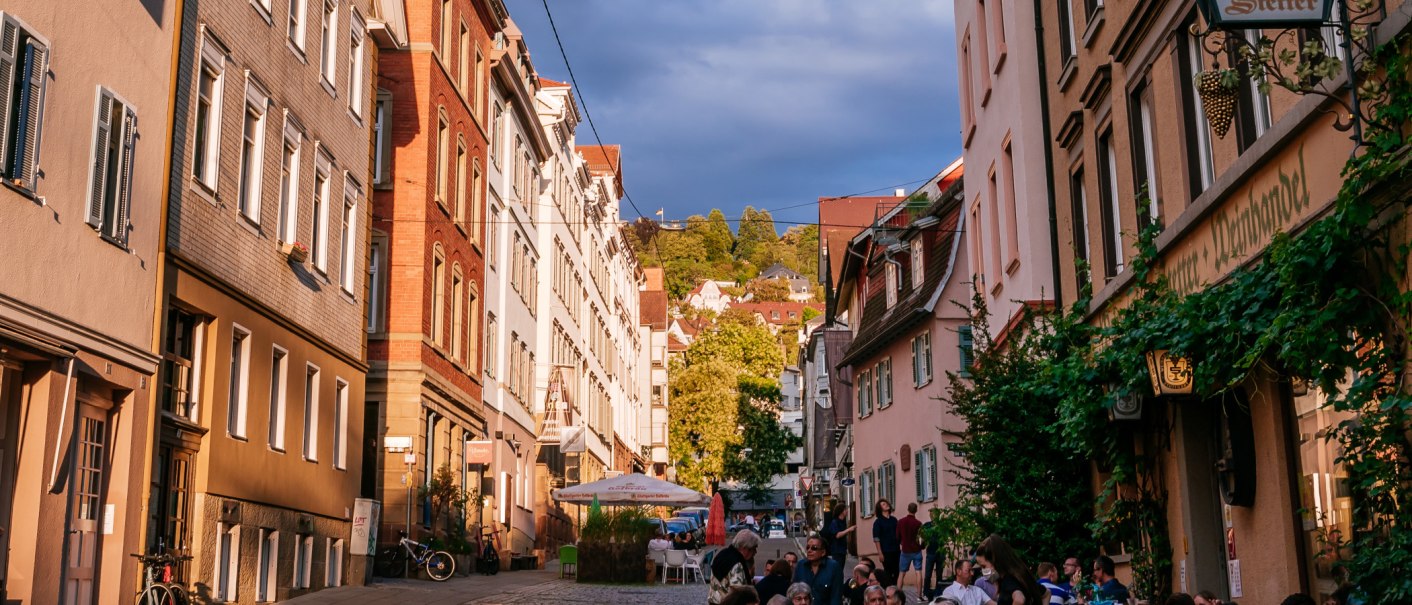Bohnenviertel (Bean Quarter)
Antique shops, artists' studios, cosy cafés and quaint wine taverns - the Bohnenviertel is a Stuttgart district with charm and history! The wine taverns are reminiscent of the winegrowers' taverns, whose vineyards began directly behind Weberstraße. And the Viertele taste at least as good today as they did back then in the cosy inns!
Take time to browse - the small shops, second-hand bookshops and galleries are real treasure troves. Whether shopping or visiting a restaurant - a discovery tour through Stuttgart's bean quarter is worthwhile. One of the highlights of the district is the annual Stuttgart Bohnenviertelfest: live music, tasty treats, cool drinks and a great atmosphere!
Where the name comes from:
It was the poorer population of Stuttgart who lived in this part of the city. Their main food: the garden bean. Bean plants were planted in the gardens, even hung garland-like on the houses. There were many customs surrounding the bean: for example, once a year a cake was baked and divided into pieces. One of the pieces contained a bean. Whoever got this piece of cake was allowed to hold court as "bean king" at a feast. Towards the end of the 19th century, blocks of buildings and commercial enterprises took the place of the gardens in the bean quarter. When the district was to be built over in the 1970s, the local population campaigned instead for a typical inner-city quarter for living and working. After a competition, courtyards were planted with greenery, children's playgrounds were built and traffic was calmed down. The neighbourhood was redeveloped with respect for the typical character of the Bohnenviertel, the urban mix of living and working and the existing old buildings were preserved as far as possible.
History of the "Bean Quarter"
In 1392 Count Eberhard III of Württemberg returned from a journey to Prague with the idea of expanding the city. Based on the design of the recently completed Prague New Town the suburb to the south of Stuttgart was extended by the addition of a central trading area, the Hauptstätter Strasse, named after the nearby execution site (Enthauptung = beheading).
The Leonhardsvorstadt was completed around 1415. This was where the craftsmen lived who were dependent on the Nesenbach stream for their water supply - for instance tanners, dyers, butchers - or whose fires constituted a danger to the closely-packed buildings in the heart of the city, e.g. brickmakers, smiths or potters who had to fire their clay pots.
It was the poorer section of Stuttgart's population that lived here. Their staple diet was beans, which thrived on the Keuper marly soil and gave the area its name of "Bohnenviertel", which means Bean Quarter.
Beans were planted in the gardens behind and between the houses, or - with express official permission - even draped round the houses like garlands. There were a great many traditions, songs and rhymes to do with beans.
Towards the end of the 19th century there was a great shortage of living space in Stuttgart. Houses were built on every available site. The gardens of the Bean Quarter were therefore replaced by blocks of buildings where tradespeople settled.
In 1970 the townspeople expressed a wish to preserve the quarter as a typical inner city area where people could live and work. The experts endorsed this idea and in 1976 another competition was announced with the aim of modernising and conserving the Bean Quarter without destroying its typical, unique character. Importance was placed on maintaining the urbane blend of living and working, preserving the existing old buildings as far as possible and creating new ones which merged with the structures which had evolved over the years. The redevelopment project was completed in the early 1990s and is considered a prime example of successful redevelopment of evolved areas in critical inner city locations.

